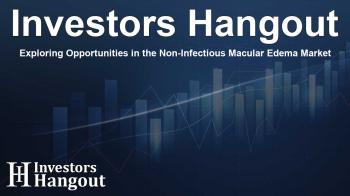Exploring Opportunities in the Non-Infectious Macular Edema Market

The Expanding Horizon of Non-Infectious Macular Edema Treatment
The global non-infectious macular edema treatment market is poised for substantial growth, projecting a compound annual growth rate (CAGR) of 6.9%. This growth is set to elevate the market's valuation significantly in the coming years, highlighting an increasing recognition of ophthalmic diseases and advancements in treatment methodologies.
Current Market Valuation and Future Forecast
As we venture deeper into this evolving landscape, market analysts estimate the global non-infectious macular edema treatment market will reach approximately US$ 15,121.9 million in 2024. By the end of 2034, this figure is forecasted to grow to around US$ 29,567.8 million. These projections underscore the growing clinical demand and the innovative pipeline of therapies targeting this condition.
Technological Innovations Fueling Growth
Revolutionary advancements in biologics and gene therapies are opening new therapeutic avenues for treating non-infectious macular edema. These innovative approaches promise targeted and long-lasting effects, which are highly sought after in ocular treatment.
The Potential of Regenerative Medicine
Research into regenerative medicine is gathering momentum, particularly studies on stem cell therapy and tissue engineering. These avenues hold great potential for transforming the treatment paradigms for ocular diseases, possibly including non-infectious macular edema.
The Role of Artificial Intelligence in Diagnostics
Artificial intelligence (AI) and machine learning are making their marks within the diagnostic realm of non-infectious macular edema. By enhancing diagnostic accuracy and efficiency, these technologies enable timely interventions, leading to improved patient outcomes.
Key Market Segments and Dynamics
The diabetic macular edema segment is predicted to be a major player in this market, anticipated to capture approximately 52.6% of the market share by 2034. Additionally, the anti-VEGF treatment category is expected to secure around 67.7% of the market in the same timeframe.
Increased Awareness and Education
Education initiatives play a crucial role in increasing awareness about non-infectious macular edema. Emphasizing the importance of regular eye check-ups and adherence to prescribed treatments can foster a proactive approach to disease management.
Market Competitors and Their Contributions
Several key players are driving innovation in this field, including Allergan, Amgen, and Pfizer. These companies are not only developing new therapies but also collaborating with healthcare institutions to enhance product accessibility. For instance, Pfizer is exploring broader therapeutic options within the ophthalmology sector.
The Impact of Collaborative Efforts
Collaborations between pharmaceutical firms and research institutions are vital for accelerating the development and commercialization of new treatments for non-infectious macular edema. By pooling resources and expertise, these partnerships can usher in groundbreaking therapies.
Continued Research and Future Directions
Ongoing research into combination therapies, which employ multifaceted approaches to combat the complexities of non-infectious macular edema, indicates a trend towards more effective treatment strategies. Such strategies address various disease aspects simultaneously, paving the way for more holistic patient care.
A Forward-Looking Perspective
With a dynamic landscape ahead, varying regional markets are set to grow uniquely. For instance, Latin America anticipates a CAGR of 7.0% by 2034, reflecting regional variations in disease prevalence and treatment needs.
Frequently Asked Questions
What is the projected market size for non-infectious macular edema treatment?
The projected market size is expected to reach around US$ 29.6 billion by the end of 2034.
What therapies are expected to dominate the market?
The diabetic macular edema segment is forecasted to dominate the market, predicted to hold 52.6% of the market share in 2034.
How important is technology in the treatment of macular edema?
Technology, especially AI and machine learning, is pivotal in enhancing diagnostic accuracy and promoting timely interventions for patients.
Which companies are leading the market in innovation?
Key innovators include Allergan, Amgen, and Pfizer, known for their contributions to developing effective therapies.
What future trends are expected in the market?
Future trends include increased emphasis on patient education, combination therapies, and collaborative partnerships, enhancing treatment access and effectiveness.
About The Author
Contact Thomas Cooper privately here. Or send an email with ATTN: Thomas Cooper as the subject to contact@investorshangout.com.
About Investors Hangout
Investors Hangout is a leading online stock forum for financial discussion and learning, offering a wide range of free tools and resources. It draws in traders of all levels, who exchange market knowledge, investigate trading tactics, and keep an eye on industry developments in real time. Featuring financial articles, stock message boards, quotes, charts, company profiles, and live news updates. Through cooperative learning and a wealth of informational resources, it helps users from novices creating their first portfolios to experts honing their techniques. Join Investors Hangout today: https://investorshangout.com/
The content of this article is based on factual, publicly available information and does not represent legal, financial, or investment advice. Investors Hangout does not offer financial advice, and the author is not a licensed financial advisor. Consult a qualified advisor before making any financial or investment decisions based on this article. This article should not be considered advice to purchase, sell, or hold any securities or other investments. If any of the material provided here is inaccurate, please contact us for corrections.

